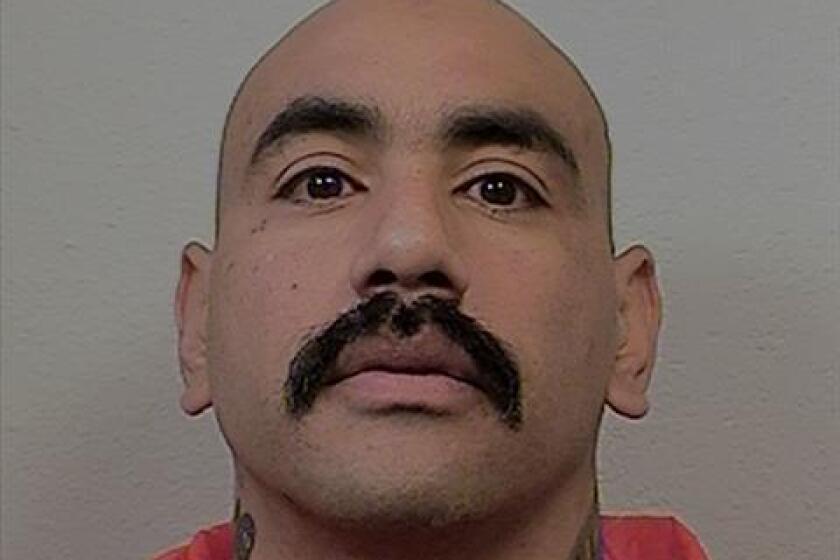Medical Board Lagging in Disciplinary Action : Doctors: A judge’s rebuke of state agency’s role in Klvana case underscores criticism from other sectors.
After a jury convicted Dr. Milos Klvana of second-degree murder in the deaths of eight newborns and a fetus, the judge who heard the case called it “a testament to the abject failure” of the Medical Board of California, the state agency charged with protecting the public from incompetent and negligent physicians.
Evidence of Klvana’s gross malpractice had been piling up for nearly a decade before he was brought to justice. At his sentencing in February to a 53-year prison term, Los Angeles Superior Court Judge Judith C. Chirlin said the medical board must “accept responsibility for at least some of the deaths,” because of its repeated failures to investigate the doctor properly and stop him from practicing medicine.
Though stung by the criticism, medical board officials downplay the case. The agenda for a recent meeting of the board’s public information committee termed the Klvana affair a “media circus” requiring “damage control.”
“You will always find an outlandish case or a problem case, something that could go through the cracks,” said Dr. J. Alfred Rider of San Francisco, the medical board’s president. He insists there is no “big problem” in physician discipline in California and praises the board and its staff as “absolutely magnificent and dedicated to the consumer of this state.”
But a Times examination of the issue casts serious doubt on any sanguine view of California’s doctor-disciplinary system.
* At the end of March, the board had a backlog of 600 patient complaints set for formal investigation but still not assigned. The unassigned complaints are primarily in Los Angeles and Orange counties and in the San Francisco Bay Area. Officials say the figure is actually a decrease from previous months.
* An additional 500 cases are caught in a bottleneck at the state attorney general’s office, whose lawyers try disciplinary cases against physicians, and at the state Office of Administrative Hearings, whose judges hear the cases.
* Cases that are under investigation drag on for years. Routine cases can take two to three years from complaint to final action and some can take five years or more.
* The medical board lacks important investigative powers. When it finds wrongdoing in the treatment of one patient, it has no authority to spot-check the doctor’s records for a pattern of poor care. Nor is the board routinely or promptly informed of many serious allegations against doctors that surface elsewhere.
* The board and the attorney general’s office have failed to exercise all the legal options at their disposal to stop potentially dangerous doctors from practicing while their cases are proceeding.
Perhaps all this helps explain why in 1987, California ranked 42nd among the states in the number of serious disciplinary actions, per 1,000 licensed physicians, according to figures compiled by the Federation of State Medical Boards and analyzed by the Public Citizen Health Research Group of Washington. In 1986, California ranked 30th.
Licensing and disciplining physicians are state government responsibilities. But individual state medical boards vary widely in the powers they are granted under state laws and the resources that are made available to them. Foundation officials note that bad physicians may not be equally distributed throughout the country and that a state doing a good job of denying licenses to unqualified doctors may need to bring fewer disciplinary cases.
But there is no reason to believe that California physicians as a group are better or worse than those in such states as New York, which ranked 15th in the 1987 discipline statistics, or Massachusetts, which ranked 20th. Medical boards in both of those states meted out more than 2 1/2 times as many serious disciplinary actions, per thousand physicians, than did the California medical board.
Although national figures are not available for 1988 or 1989, California probably ranks no better today. Over the last three years, the number of serious disciplinary actions taken by the board has steadily declined, according to its own records.
The legislative analyst’s office, which monitors the performance of state agencies for the California Legislature, found in a recent investigation that a majority of the board’s unassigned cases “have a potential for physical harm to the public.” It concluded that “the board’s effectiveness in protecting the public is questionable.”
Kenneth J. Wagstaff, the board’s executive director, said the criticism of the agency is unfair because legal and financial constraints limit the board’s “moral mandate to look out for the security of the public.”
One constraint is the board’s limited access to information.
The board gets its caseload from patient complaints, and from notices of hospital disciplinary actions and malpractice payouts of more than $30,000.
It can review the records of a patient who files a complaint against his doctor. But it lacks the legal authority to take the next step and spot-check the doctor’s records for patterns of poor care to other patients.
It also cannot obtain detailed hospital records that explain why a physician’s privileges were terminated.
When a doctor is convicted of a crime, the board is notified by the court. But the board is not told at the time criminal charges are filed, although this information is a matter of public record. Similarly, it is notified of civil judgments in excess of $30,000, but not of judgments for lesser amounts.
In addition to citing legal constraints, Wagstaff points a finger of blame at the attorney general’s office and at the state Office of Administrative Hearings.
“There are now over 500 cases of ours in the attorney general’s office at various stages of review and litigation,” Wagstaff said.
Richard Martland, chief of the attorney general’s civil law division, said he “wouldn’t disagree” with the 500-case figure cited by Wagstaff.
“Yes, we’re understaffed,” he said. “We’ve been telling many administrations that fact, and basically we don’t make these decisions. The governor makes those decisions and the Legislature.”
Wagstaff also cited six-month delays in Southern California between the time a discipline hearing is requested and when it is actually held.
Karl Engeman, the director of the Office of Administrative Hearings, acknowledged that under current staffing the six-month figure was “reasonably accurate” for routine cases but that emergency cases could be heard “as soon as the attorneys are ready to go.”
While cases drag on, physicians can usually continue to practice without restriction. Final board disciplinary decisions can be appealed to the Superior Court and higher courts, adding years of additional delays.
State law requires the board to seek a court injunction against physicians when there is reasonable cause to believe that their continued medical practice would endanger the public health, safety or welfare. Such temporary restraining orders typically restrict or halt a physician’s practice while an investigation continues.
But the medical board obtained only five temporary restraining orders against health-care professionals during a three-year period ending in June, 1989, according to its records. Another four temporary restraining orders have been obtained since last December’s Klvana verdict, which placed the board’s performance under increased legislative and public scrutiny.
Wagstaff acknowledged that temporary restraining orders are rarely sought. He said judges reject such requests unless there is overwhelming evidence of ongoing public endangerment and that a rejected request can jeopardize subsequent proceedings against a physician. But he said the law should be changed to make it easier for such orders to be obtained.
Much of the disciplinary process occurs out of public view. Consumers cannot learn the results of most investigations, including the hundreds each year in which physicians are sent warning letters or are called in for informal “non-disciplinary” reviews of their practices.
Formal accusations to revoke or suspend a physician’s license are made public, but there is no mechanism to assure that a doctor’s patients are informed.
Consumers who have the legal right to be informed of significant defects in used cars and houses “should certainly have the right to be informed by the physician whose services he or she is contemplating using if that physician has been found guilty of unprofessional conduct of any type,” according to Frank Albino, a Los Angeles attorney who is vice president of the board’s division of medical quality. Albino acknowledged, however, that a majority of board members probably disagreed with this view.
Even routine information is hard to obtain. A person telephoning the medical board to find out if a physician is licensed or has been disciplined is very likely to get a busy signal. This is because the agency’s phone lines are ill-equipped to handle the demand for information from the public.
Times reporters tried these phone lines many times over several weeks but reached the board only sporadically. The phones are an “area of colossal inefficiency which has improved somewhat but which is still problematic,” according to Linda Ramsey, a California Medical Assn. official who monitors the board’s activities.
The phone logjam underscores what board officials view as a larger problem--the agency is understaffed and underfunded.
Charged with overseeing the licenses of about 150,000 doctors and other health professionals, it operates with an enforcement budget of about $7.57 million a year. The money comes from license fees that are collected by the board, but its expenditures must be appropriated by the Legislature.
Out of those fees, the board spends $78 per licensed physician on enforcement, contrasted with $276 per lawyer by the State Bar, according to Wagstaff.
Last year, the Legislature allocated the board $2.4 million to increase its staff of investigators from about 40 to 58 and to add 10 other enforcement staff positions. As of March, seven of the investigator positions remained vacant. Of the board’s 51 investigators, only 26 had more than a year’s experience on the job.
Wagstaff says it is difficult to recruit, train and retain investigators. Seasoned investigators are being lured away by other state agencies, where they can make more money with lighter caseloads, he said.
Senior medical investigators can make a maximum of about $41,000 a year, contrasted with more than $50,000 a year at some other state agencies.
“I think it is scandalous,” Wagstaff said.
The board is short of money and investigators, but its problems go beyond that, said Dr. Laurens White, who served in 1988-89 as president of the CMA, the organization representing about half of California’s physicians.
“The board is just not tough enough,” said White, a San Francisco oncologist. “They don’t need to be as slow as they are.”
The medical association has supported the enforcement of existing physician-discipline laws and backed a recent increase in physician-license fees which helped pay for more investigators.
But the CMA has opposed proposals that would make it easier for the board to gain additional information about a physician’s practices as well as procedural reforms that would speed discipline and make it easier for the board to revoke a physician’s license.
The CMA’s Ramsey said the board has improved over the years but is still “slow,” “complacent,” “inefficient,” and not making the best use of the authority it already has. She downplays Wagstaff’s contention that legal and financial constraints are the main culprit and questions whether board officials “are excusing their own inactivity.”
“We have been railing about them for inefficiency forever,” Ramsey said. “I have been at CMA 20 years and I can’t remember when we ever indicated that we were satisfied with their efficiency.”
Ramsey said the board was “fairly complacent” for years about its “inadequate” number ofinvestigators, its “extremely long investigatory cases,” and the small number of temporary restraining orders. Then it began getting “a tremendous amount of public heat” from the Klvana case and a critical 1989 report on doctor discipline, prepared by the University of San Diego’s Center for Public Interest Law.
Before the publicity, “Why weren’t they beating down the governor’s door and saying, ‘Look, we can’t do our job and there are some pretty scary things in our case files, and if you don’t give us the money we are going to The Los Angeles Times and say that we cannot investigate them’?”
Other critics, such as consumer-advocate groups, say the board spends too much time trying to rehabilitate physicians and not enough time weeding out bad doctors.
The practice of medicine, they argue, is a privilege that creates responsibilities to adhere to high medical and ethical standards, not an irrevocable right that individuals acquire by attending medical school and completing further medical training.
“When you’ve got somebody who really has lost it, you’ve got to get them out of there, and that is not happening,” said Robert C. Fellmeth, the director of the University of San Diego’s Center for Public Interest Law and the author of the critical 1989 report, “Physician Discipline in California: A Code Blue Emergency.”
Another criticism is that many of the board’s disciplinary actions center on egregious behaviors, such as prescribing narcotics for personal use or sexual misconduct with patients, and worthless treatments, such as the use of swamp water to treat cancer or urine injections to treat allergies.
Far fewer investigations target less bizarre forms of poor medical care, which are often more subtle and difficult to prove. These include botched diagnoses, unnecessary surgeries, and illnesses caused by incorrect use of drugs or poor surgical technique.
Supporters of current board policies say the agency should make every effort to rehabilitate physicians and reserve serious penalties for the most egregious cases.
They say that physicians have a right to earn a living after investing many years and tens of thousands of dollars in medical training. They stress that physicians, like anyone else, are entitled to full due process under the law.
“When your license is suspended as a doctor, you quit existing. It is a very major thing,” said Dr. William G. Plested, a former CMA president whose term expired in March.
“No other profession undergoes the scrutiny that physicians do”--scrutiny from themselves, colleagues, hospitals and professional societies, added Plested, a Santa Monica surgeon. “And in spite of this, people who have not been reviewed for one minute of their entire professional life are quick to point their fingers at doctors.”
Nobody knows for certain how often patients are harmed by poor medical care. But, after a detailed study of hospitals in New York State, Harvard University researchers estimated that medical injuries caused 2,500 cases of permanent medical disability in 1984 and “contributed at least in part to the deaths of more than 13,000 patients in that year.”
The study, which was released in March, acknowledged that “many of the deaths occurred in patients who had greatly shortened life expectancies from their underlying diseases, however.”
In total, the New York study estimated that 1% of all hospital patients were victims of medical negligence, although in the majority of instances the disability they suffered was “minimal and transient.” It also found that eight times as many patients suffered an injury from medical negligence than filed a malpractice claim. Many of the results of the New York study were similar to those found in a landmark California Medical Assn. study a decade earlier.
“There are a large number of doctors--not the majority by any means, but not just an occasional one--who are menaces to society and should not be allowed to practice,” said White, who served as president of the CMA before Plested.
Dr. Jeff Gordon, a San Diego family practitioner and medical board member from 1976 to 1984, said: “The board gets to deal with the very tip of the iceberg. . . . A lot of bad medicine goes on without the board being able to do anything about it.”
But Dr. Richard Ikeda, the chief medical consultant for the medical board, disagreed.
“There are damn few patients out there who think their doctors are doing crummy jobs,” he said at a recent board committee meeting. “The 70,000 practicing doctors in this state are damn good, and the bad ones we get.”
Critics of the board maintain that such blanket assertions are disproved by the case of Milos Klvana, the Valencia physician convicted in December of second-degree murder in the deaths of eight newborns and a fetus in his care.
The board had placed Klvana on five years’ probation in 1980 after he was convicted of excessive prescribing, a misdemeanor. It lifted the probation in 1983, two years early. The deaths, many of which were caused by improper use of a labor-inducing drug, occurred between 1982 and 1986.
Judge Chirlin, who heard the case against Klvana, chastised the board for not monitoring the physician’s probation properly and for botching its own investigation of some of the deaths.
The board, for example, relied upon Klvana’s version of events to close an investigation into one of the deaths that later resulted in a murder conviction, according to court documents.
And the board disregarded the opinion of one of its own medical consultants who described Klvana’s care as “grossly negligent, but no different from many situations in the Third World where only marginal medical care is available.”
The board took no action to prevent Klvana from practicing medicine until 1988, after he had been in jail for more than a year awaiting trial.
No one familiar with the evidence “could possibly come to the conclusion that the system is adequate and that there is no need for major institutional reform,” Chirlin said before sentencing Klvana to 53 years to life in state prison.
The Klvana case is a particular sore point with board members. “To bring that one case and hit us with it over and over and over again, I don’t think is right,” said board member Dr. John C. Lungren, a Sacramento-area physician.
Rider, the medical board president, said that “significant improvements” in board procedures and personnel would prevent a similar situation from developing today. “I am getting sick and tired of hearing this case,” he said at a board executive committee meeting in March.
But others say that such reactions, as well as the characterization of the Klvana case as a “media circus,” demonstrate that the board has not yet come to grips with the seriousness of the issue.
“Now they have a public relations committee and they are writing more press releases,” said the CMA’s Ramsey. “That to me is saying: ‘Well, they think they are doing a good job and they feel the word isn’t getting out. . . .’ I don’t see any radical change in any of this.”
HOW TO CONTACT THE MEDICAL BOARD Information about how to file a complaint against a physician can be obtained by calling the Medical Board of California at 1-800-MEDBDCA. Calls are automatically routed to the medical board’s nearest regional office. The regional offices and their telephone numbers are:
Fresno (209) 445-5664
Sacramento (916) 920-6013
Santa Ana (714) 558-4452
Santa Rosa (707) 576-2715
San Bernardino (714) 383-4755
San Mateo (415) 573-3892
Torrance (213) 320-8530
Woodland Hills (818) 713-0124
During 1990, the board plans to open additional regional offices in Concord and Diamond Bar.
Disciplinary information about physicians and verification of their licenses can be obtained by calling the medical board in Sacramento at (916) 920-6343.
Complaints against allied health professionals can be made by calling (916) 920-6341.
THE DISCIPLINARY PROCESS Between July, 1988, and June, 1989, the Medical Board of California received 6,293 complaints about physicians and health care professionals. This is what the board did with these complaints.
Over the last three fiscal years, the board has received an increasing number of complaints about health care professionals. More investigations have been opened and formal accusations filed. But the number of final disciplinary actions has decreased.
COMPLAINTS: Complaints received 6,293
REFERRALS: Complaints referred to other agencies 823. Complaints disposed without formal investigation 2,023
INVESTIGATIONS: Investigations opened 3,016 Investigations completed 2,361
ATTORNEY GENERAL’S OFFICE: Cases fowarded from Medical Board 343 Accusations Filed 201Temporary Restraining Orders 2
COMPLIANCE ACTIONS: Medical Education Conferences 392 Warning Letter 131. Voluntary Psychiatric Exam 12. Voluntary Competency Exam 33. Referral to Diversion Program 37
DISPOSITION: Final disciplinary actions 84. (licenses revoked, suspended, surrendered, probation)
1986/87 1987/88 Complaints Received 5,514 5,960 Formal Investigations Opened 2,697 2,445 Formal Accusations Filed 137 174 Final Disciplinary Actions (licenses revoked, surrendered, suspended, probation) 144 126 Temporary Restraining Orders 3 0
1988/89 Complaints Received 6,293 Formal Investigations Opened 3,016 Formal Accusations Filed 201 Final Disciplinary Actions (licenses revoked, surrendered, suspended, probation) 84 Temporary Restraining Orders 2
Source: Medical Board of California
More to Read
Sign up for Essential California
The most important California stories and recommendations in your inbox every morning.
You may occasionally receive promotional content from the Los Angeles Times.






